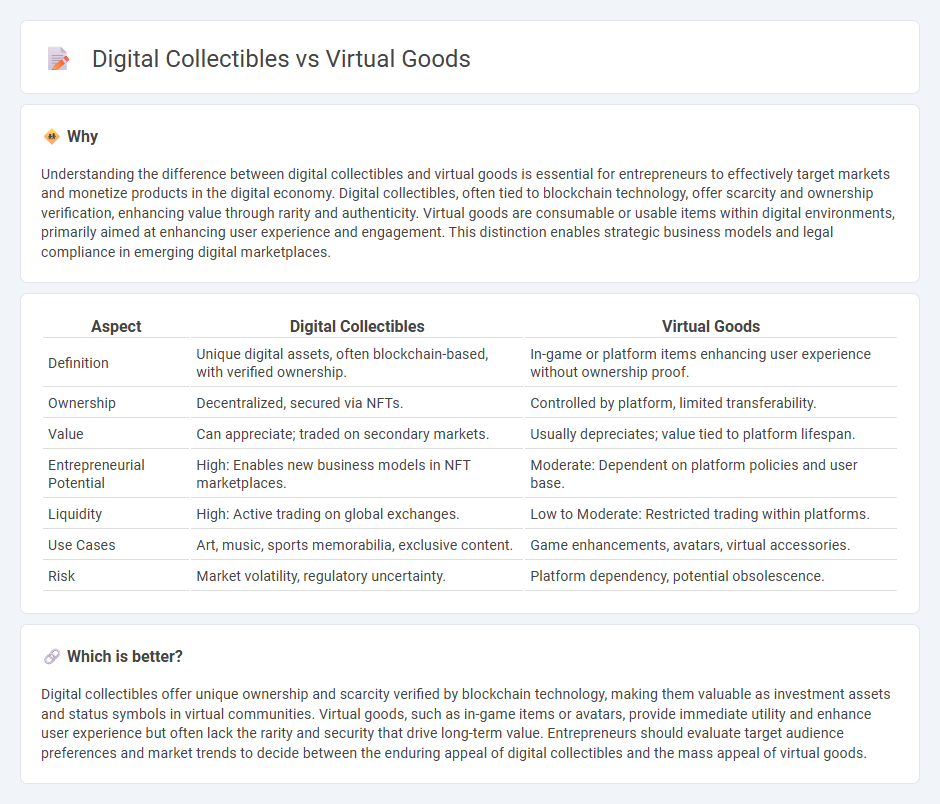
Digital collectibles represent unique, blockchain-certified assets that offer verifiable scarcity and ownership, enhancing value in the virtual marketplace. Virtual goods encompass a broader category of in-game items and digital assets used for personalization or utility, often lacking the exclusivity digital collectibles hold. Explore how these distinctions impact entrepreneurial opportunities and market dynamics in the digital economy.
Why it is important
Understanding the difference between digital collectibles and virtual goods is essential for entrepreneurs to effectively target markets and monetize products in the digital economy. Digital collectibles, often tied to blockchain technology, offer scarcity and ownership verification, enhancing value through rarity and authenticity. Virtual goods are consumable or usable items within digital environments, primarily aimed at enhancing user experience and engagement. This distinction enables strategic business models and legal compliance in emerging digital marketplaces.
Comparison Table
| Aspect | Digital Collectibles | Virtual Goods |
|---|---|---|
| Definition | Unique digital assets, often blockchain-based, with verified ownership. | In-game or platform items enhancing user experience without ownership proof. |
| Ownership | Decentralized, secured via NFTs. | Controlled by platform, limited transferability. |
| Value | Can appreciate; traded on secondary markets. | Usually depreciates; value tied to platform lifespan. |
| Entrepreneurial Potential | High: Enables new business models in NFT marketplaces. | Moderate: Dependent on platform policies and user base. |
| Liquidity | High: Active trading on global exchanges. | Low to Moderate: Restricted trading within platforms. |
| Use Cases | Art, music, sports memorabilia, exclusive content. | Game enhancements, avatars, virtual accessories. |
| Risk | Market volatility, regulatory uncertainty. | Platform dependency, potential obsolescence. |
Which is better?
Digital collectibles offer unique ownership and scarcity verified by blockchain technology, making them valuable as investment assets and status symbols in virtual communities. Virtual goods, such as in-game items or avatars, provide immediate utility and enhance user experience but often lack the rarity and security that drive long-term value. Entrepreneurs should evaluate target audience preferences and market trends to decide between the enduring appeal of digital collectibles and the mass appeal of virtual goods.
Connection
Digital collectibles and virtual goods are revolutionizing entrepreneurship by creating new revenue streams in the digital economy through blockchain technology and non-fungible tokens (NFTs). Entrepreneurs leverage these assets in gaming, art, and metaverse platforms to engage users and monetize unique digital experiences. The integration of virtual goods enhances market dynamics by fostering innovation in digital ownership, scarcity, and user interaction.
Key Terms
Ownership
Virtual goods refer to in-game items like skins, weapons, or currency that provide utility or cosmetic enhancement but are typically owned and controlled by the game developer. Digital collectibles, often powered by blockchain technology, grant verifiable ownership and uniqueness to the user, enabling true possession, transferability, and potential appreciation in value. Explore the distinctions between virtual goods and digital collectibles to understand their impact on digital ownership rights.
Scarcity
Virtual goods often lack scarcity as they can be replicated infinitely within digital environments, reducing their perceived value. Digital collectibles, especially those secured by blockchain technology, emphasize scarcity by offering unique, verifiable ownership and limited editions, driving demand and exclusivity. Explore the nuances of scarcity in virtual goods and digital collectibles to understand their impact on digital economies and collector behavior.
Interoperability
Virtual goods are digital items primarily used within a specific game or platform, with limited or no interoperability across different environments. Digital collectibles, such as NFTs, emphasize interoperability by allowing ownership, transfer, and use across multiple platforms and ecosystems. Explore how interoperability shapes the future of digital assets and user experiences.
Source and External Links
11 Examples of Virtual Goods - Simplicable - Virtual goods are products and services existing solely in virtual worlds, such as currencies, avatars, clothing, property, powers, tools, gifts, collectibles, services, events, and virtual consumables used mainly in games or virtual environments.
Virtual goods - Wikipedia - Virtual goods are intangible, non-physical objects purchased for use in online games or communities, usually sold through microtransactions within freemium models, including digital items like avatar clothing or in-game currency.
Virtual Good - Overview, Applicability, and Related Issues - Virtual goods are non-physical assets traded in online marketplaces, commonly in video games and social media to unlock features or customization, though users generally do not hold ownership rights, as publishers retain control.
 dowidth.com
dowidth.com